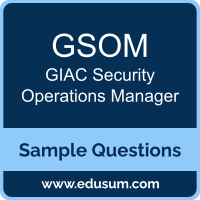01. Which of the following best represents a principle of defensible security architecture?
a) Single layer of security at the network perimeter
b) Neglecting the importance of data encryption
c) Isolation of IT systems for easier management
d) Implementing defense-in-depth with layered controls
02. Which of the following best describes the role of automation in optimizing SOC operations post-incident?
a) Automates routine tasks to reduce human error
b) Replaces the need for human analysis entirely
c) Increases the incidence of false positives
d) Decreases the speed of incident response
03. When assessing data sources for SOC monitoring, what is an important consideration related to organizational specific use cases?
a) Implementing the same use cases across different organizations
b) Customizing data collection methods to fit these use cases
c) Choosing use cases that are easiest to implement, regardless of relevance
d) Avoiding the use of use cases to simplify data collection
04. To effectively detect advanced persistent threats (APTs), a SOC should:
(Choose two)
a) Rely exclusively on signature-based detection
b) Utilize behavioral analysis to identify subtle indicators of compromise
c) Engage in continuous information sharing with similar organizations
d) Assume APTs cannot bypass traditional security measures
05. Effective alert creation should:
(Select all that apply)
a) Generate a high volume of alerts to increase the chances of detecting incidents
b) Utilize contextual information to enhance alert relevancy
c) Incorporate thresholds to prevent alert fatigue
d) Be configurable and adaptable over time
06. What role does 'Threat Hunting' play in cyber defense?
a) It passively waits for alerts from other security tools
b) It involves actively looking for indicators of compromise within an environment
c) It is solely focused on external threat intelligence gathering
d) It disregards any anomalous activity that does not match known patterns
07. In designing a defensible security architecture, which elements are critical?
(Choose two)
a) Assuming that all network traffic is benign until proven otherwise
b) Implementing security at different layers (e.g., perimeter, network, host)
c) Regular testing and updates to security controls
d) Relying solely on antivirus software for endpoint protection
08. Why is it important to integrate endpoint detection and response (EDR) tools into SOC operations?
a) To provide detailed visibility into endpoint activities and potential threats
b) To replace the need for a SIEM system
c) To monitor and manage desktop environments only
d) To focus solely on external threats and ignore internal anomalies
09. Analytic testing within SOC operations can help identify:
a) The best cybersecurity insurance policies
b) Future trends in employee behavior
c) Weaknesses in the incident response plan
d) The most efficient software update schedules
10. How can industry frameworks assist in the planning and prioritization of data collection for SOC monitoring?
a) By providing specific data sources to collect from, regardless of organizational context
b) By offering best practices and standards for structuring data collection
c) By eliminating the need for organizational input
d) By mandating uniform data collection processes across industries
 The purpose of this Sample Question Set is to provide you with information about the GIAC Security Operations Manager (GSOM) exam. These sample questions will make you very familiar with both the type and the difficulty level of the questions on the GSOM certification test. To get familiar with real exam environment, we suggest you try our Sample GIAC GSOM Certification Practice Exam. This sample practice exam gives you the feeling of reality and is a clue to the questions asked in the actual GIAC Security Operations Manager (GSOM) certification exam.
The purpose of this Sample Question Set is to provide you with information about the GIAC Security Operations Manager (GSOM) exam. These sample questions will make you very familiar with both the type and the difficulty level of the questions on the GSOM certification test. To get familiar with real exam environment, we suggest you try our Sample GIAC GSOM Certification Practice Exam. This sample practice exam gives you the feeling of reality and is a clue to the questions asked in the actual GIAC Security Operations Manager (GSOM) certification exam.